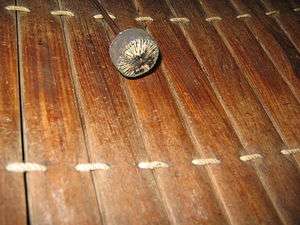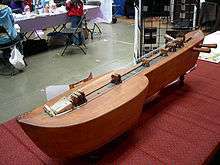Traditional Cambodian musical instruments

Traditional Cambodian musical instruments are the musical instruments used in the traditional and classical musics of Cambodia. They comprise a wide range of wind, string, and percussion instruments, used by both the Khmer majority as well as the nation's ethnic minorities.
WoodWind
Flutes
- Khloy - vertical duct flute made of bamboo, hardwood, or plastic, with buzzing membrane
- Khloy ek - smaller in size
- Khloy thom - larger in size
Free-reed
- Sheng - water buffalo or ox horn with a single free reedphoto
- Pey pok - free-reed pipephoto
- Ploy (also called m'baut) - mouth organ with gourd body and five to seven bamboo pipes; used by Mon-Khmer-speaking upland ethnic minorities
- Ken/Khaen - free-reed mouth organ used in northwestern Cambodia
- Snaeng - buffalo horn trumpet
- Angkuoch (also called kangkuoch) - jaw harp made of bamboo or metal
Quadruple Reed
- Sralai - quadruple-reed oboe
- Sralai toch - small quadruple-reed oboe
- Sralai thom - large quadruple-reed oboe
- Pey ar (also spelled beyaw, and also called bey prabauh) - oboe with cylindrical bore
Horns
- Saing - conch horn
Other
- Slek - tree leaf used as a wind instrument
String
Bowed

- Tro - fiddle
- Tro Khmer - three-string vertical spike fiddle with coconut shell body; used in classical music
- Tro che - high-pitched two-string vertical fiddle, with face covered with snakeskin
- Tro sau toch - two-string vertical fiddle with hardwood body; used in classical music
- Tro sau thom - two-string vertical fiddle with hardwood body; used in classical music
- Tro u (also spelled tro ou) - lower two-string vertical fiddle with a coconut shell body, with face covered with calfskin or snakeskin; used in classical musicphoto
Plucked

- Chapei dong veng (ចាប៉ីដងវែង) - plucked fretted lute
- Krapeu (also called takhe) - crocodile-shaped fretted floor zither with three strings
- Kse diev (also spelled se diev or sadiev, and also called khse muoy) - chest-resonated stick zither)photo
Struck
Percussion
Drums
Gong chimes
- Kong vong toch (also called kong toch) - small gong circle
- Kong vong thom (also called kong thom) - large gong circle
- Kong mon (also called kong mon) - small gong chime shaped curved
- Kong wong lek (also called kong wong lek) - small gong chimes shaped circle
- Kong wong yai (also called) kong wong yai) - small gong chimes shaped circle
Keyboard
- Roneat - trough-resonated keyboard percussion instrument; generally played with two mallets and used in Khmer classical and theater music
- Roneat ek - smaller xylophone
- Roneat thung - larger xylophone
- Roneat dek - smaller metallophone
- Roneat thong larger metallophone; no longer used
Gongs
- Kong vong - single suspended gong
Clappers
- Krap - pair of flat bamboo or hardwood sticks
Cymbals
Woodblocks
- Pan - woodblock
- Nay pay - Pellow
- Sindang - Small Size Woodblocks
Occasions
Traditional Cambodian musical instruments plays a significant role in the Cambodian culture.[1] These instruments are typically used during royal events, weddings, and festivals. For weddings and royal events, the musicians playing the instruments would wear traditional Cambodian attire. Just like the Chinese, with regard to playing context, there is no conductor in traditional Cambodian music because musicians generally learned and memorized how to play the instruments aurally. These instruments provides a sense of identity for the Cambodian people.
References
- ↑ May M. Ebihara, Carol Anne Mortland, Judy Ledgerwood. "Cambodian Culture Since 1975: Homeland and Exile". Cornell University Press, 1994
